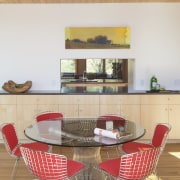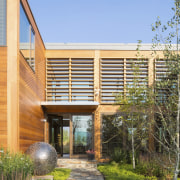Married to the land vacation home by Architects Dirk Danker and Jim Nagle
This home by Dirk Danker achieves a natural aesthetic
With a love of a pristine land comes a respect for it, and one way to celebrate this is to design a house that commands views, but not attention.
This vacation home nestles on a high butte surrounded by mountain peaks and deciduous forest. Architects Dirk Danker and Jim Nagle, of Nagle Hartray Architecture, designed the home in the post-and-beam style as this allowed a high glazing-to-structure ratio a major plus for a house intended to celebrate its surroundings.
The house comprises three principal forms. The most dramatic is a two-story pavilion that contains most public spaces the living room, dining area, kitchen and breakfast room, with a study-den in the loft. Running alongside this volume, a gallery links the building to two smaller, two-level structures that house a media room, bedrooms and the garage.
"Sliding doors on three sides and two levels of the pavilion infill the post-and-beam design, so when all doors are pulled open, the interiors merge with the outdoors," says Danker.
Despite sitting on a promontory, the house is grounded within the rugged setting, largely due to the architect's choice of naturally weathering materials, most sourced locally.
The exterior features western red cedar siding, Spanish cedar windows with bronzed cladding, and a chimney built from local stone.
"The interiors also merge with the setting in material terms, with a similar stone used on the gallery floors on both levels," says Danker. "The walls and ceilings are finished in pine, stained to the same tone as the exterior wood. The area is subject to driving winds and snow, so steel columns were needed, but they are wrapped in wood to fit the natural aesthetic."
At the center of the pavilion there is a large double-height atrium, measuring 24ft x 30ft. This affords views up through the airy volume and down from the upper gallery and study-loft lounge to the living and dining area. The loft lounge is positioned directly above the kitchen and breakfast area, screening these spaces from overhead scrutiny.
While the pavilion is a picture of glass framed by wood beams, the ancillary buildings feature a generous use of solid wood siding. These have a separated-off quality, with mainly wood siding seen from within the pavilion.
The expansive residence responds to and respects its environment in another way, too.

This was the first house in the area to gain approval for so much glazing, and the trade-off was demonstrating energy efficiency in other ways, says Keith Benjamin, project manager for constructors Teton Heritage Builders.
"A rainscreen cladding system is used on all sides of the house, even on the beams. With air circulating behind the wood, this system ensures any expansion or contraction caused by extreme temperature fluctuations occurs equally on the inner and outer side of the skin, so there is no damage to the cedar.
"Behind the rainscreen and protected by it, is an efficient thermal envelope that includes low-e double-glazed windows to minimize energy use for heating and cooling."
"The technical nature of the skin and a style of building where most elements are exposed called for a high degree of precision in all aspects of design and construction," says Danker. "Despite its rugged appeal, the home also offers every high-tech convenience remote controls and sleek touch-pads are in use throughout."
Credit list
kitchen designer
Builder
Cladding
Story by: Charles Moxham
Home kitchen bathroom commercial design
Diving into nature
Classic looks, contemporary efficiency
Personality plus















